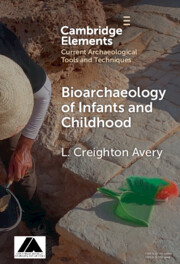Refine search
Actions for selected content:
1159 results
Chapter 14 - Stand-Up Comedy and Trauma
- from Part III - Performance Dynamics
-
-
- Book:
- The Cambridge Companion to Stand-Up Comedy
- Published online:
- 21 August 2025
- Print publication:
- 04 September 2025, pp 273-289
-
- Chapter
- Export citation

Bioarchaeology of Infants and Children
-
- Published online:
- 25 August 2025
- Print publication:
- 30 September 2025
-
- Element
-
- You have access
- HTML
- Export citation
Little lives—reading between the lines: insights from the Northampton Infirmary Eighteenth Century Child Admission Database
-
- Journal:
- Medical History , First View
- Published online by Cambridge University Press:
- 22 August 2025, pp. 1-19
-
- Article
-
- You have access
- Open access
- HTML
- Export citation
The impact of immigration detention on children’s mental health: systematic review: commentary, Liddell
-
- Journal:
- The British Journal of Psychiatry , FirstView
- Published online by Cambridge University Press:
- 19 August 2025, pp. 1-2
-
- Article
- Export citation
Positive symptoms and their associations with life and trauma events among young adults in a first-episode psychosis clinic: qualitative analysis
-
- Journal:
- BJPsych Open / Volume 11 / Issue 5 / September 2025
- Published online by Cambridge University Press:
- 15 August 2025, e178
-
- Article
-
- You have access
- Open access
- HTML
- Export citation
5 - The Chernobyl Children
-
- Book:
- Chernobyl Children
- Published online:
- 26 June 2025
- Print publication:
- 14 August 2025, pp 224-284
-
- Chapter
- Export citation
8 - Caporetto According to Cadorna: A Moral Autobiography of the Italians
- from Part III - The Downfall
-
- Book:
- The Generalissimo
- Published online:
- 31 July 2025
- Print publication:
- 14 August 2025, pp 205-228
-
- Chapter
- Export citation
Associations between premenstrual symptoms and (traumatic) stress: a systematic review and three multilevel meta-analyses
-
- Journal:
- The British Journal of Psychiatry , FirstView
- Published online by Cambridge University Press:
- 11 August 2025, pp. 1-11
-
- Article
-
- You have access
- Open access
- HTML
- Export citation
Chapter 6 - Landscapes of Memory
-
- Book:
- Healing and the Invention of Metaphor
- Published online:
- 17 July 2025
- Print publication:
- 31 July 2025, pp 146-174
-
- Chapter
- Export citation
Chapter 7 - The Texture of Time
-
- Book:
- Healing and the Invention of Metaphor
- Published online:
- 17 July 2025
- Print publication:
- 31 July 2025, pp 175-200
-
- Chapter
- Export citation
Neuropathology of Fatal Falls in Southwestern Ontario
-
- Journal:
- Canadian Journal of Neurological Sciences , First View
- Published online by Cambridge University Press:
- 25 July 2025, pp. 1-6
-
- Article
-
- You have access
- Open access
- HTML
- Export citation
A whole-brain voxel-based analysis of structural abnormalities in PTSD: An ENIGMA-PGC study
-
- Journal:
- European Psychiatry / Volume 68 / Issue 1 / 2025
- Published online by Cambridge University Press:
- 22 July 2025, e97
-
- Article
-
- You have access
- Open access
- HTML
- Export citation
Is adult-onset separation anxiety disorder a trauma-stress-related disorder? A preliminary report
-
- Journal:
- CNS Spectrums / Volume 30 / Issue 1 / 2025
- Published online by Cambridge University Press:
- 21 July 2025, e58
-
- Article
-
- You have access
- Open access
- HTML
- Export citation
Traumatic Acute Subdural Hematoma with Actively Bleeding Middle Meningeal Artery
-
- Journal:
- Canadian Journal of Neurological Sciences , First View
- Published online by Cambridge University Press:
- 16 July 2025, pp. 1-2
-
- Article
- Export citation
Chapter 11 - Disability
- from Part II - Social Contexts
-
-
- Book:
- Sean O'Casey in Context
- Published online:
- 23 June 2025
- Print publication:
- 10 July 2025, pp 120-129
-
- Chapter
- Export citation
Evaluation of Post-traumatic Stress, Depression, and Anxiety Levels in Survivors of the 2023 Kahramanmaraş Türkiye Earthquakes at the 12th Month After the Event
-
- Journal:
- Disaster Medicine and Public Health Preparedness / Volume 19 / 2025
- Published online by Cambridge University Press:
- 07 July 2025, e176
-
- Article
- Export citation
Examination of Post-Earthquake Trauma Levels of Individuals Affected by February 6, 2023 Earthquakes
-
- Journal:
- Disaster Medicine and Public Health Preparedness / Volume 19 / 2025
- Published online by Cambridge University Press:
- 02 July 2025, e169
-
- Article
- Export citation
60 - Trauma
- from Subsection 4M - Clinical – Trauma
-
-
- Book:
- Observation Medicine
- Published online:
- 27 June 2025
- Print publication:
- 26 June 2025, pp 355-362
-
- Chapter
- Export citation
Chapter 13 - Trauma and Meaning
- from Part IV - Meaning and Disturbance
-
- Book:
- The Development and Organization of Meaning
- Published online:
- 11 June 2025
- Print publication:
- 26 June 2025, pp 175-184
-
- Chapter
- Export citation
Chapter 12 - Cardiac Arrest
- from Section 2 - Crises and Complications
-
- Book:
- Robinson and Hall's How to Survive in Anaesthesia
- Published online:
- 09 June 2025
- Print publication:
- 26 June 2025, pp 77-85
-
- Chapter
- Export citation
